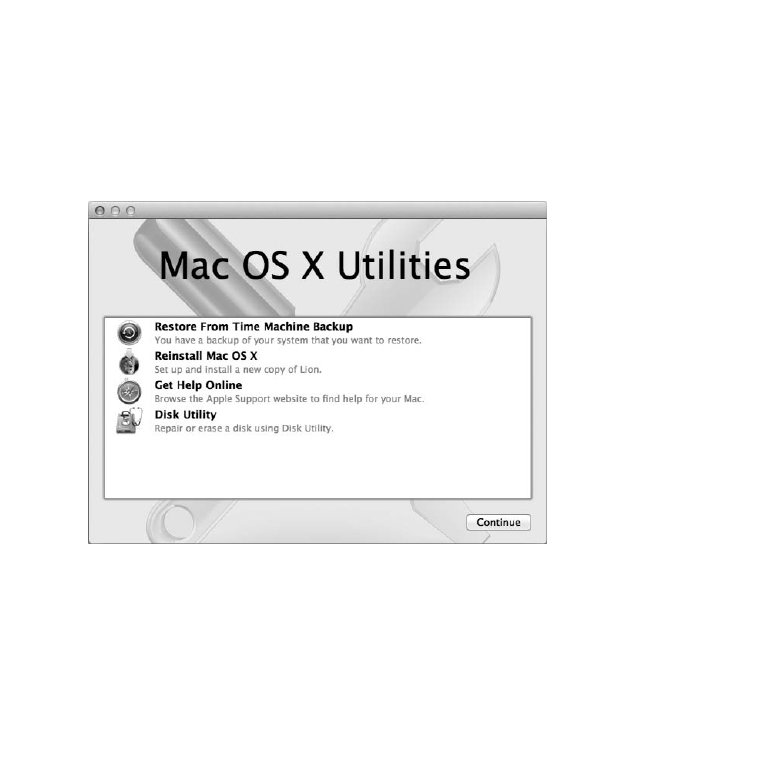
Problems That Prevent You from Using Your MacBook Air
If your MacBook Air doesn’t respond or the pointer doesn’t move
On rare occasion, an application might “freeze” on the screen. Mac OS X provides a way
to quit a frozen application without restarting the computer.
To force an application to quit:
1
Press Command (x)-Option-Esc or choose Apple () > Force Quit from the menu bar.
The Force Quit Applications dialog appears with the application selected.
2
Click Force Quit.
The application quits, leaving all other applications open.
If you need to, you can also restart the Finder from this dialog.
Next, restart your MacBook Air to make sure the problem is entirely cleared up.
If the problem occurs frequently, choose Help > Help Center from the menu bar at the
top of the screen. Search for the word “freeze” to get help for times when the computer
freezes or doesn’t respond.
If the problem occurs only when you use a particular application, check with
the application’s manufacturer to see if the application is compatible with your
MacBook Air. To get information for the software that came with your MacBook Air,
go to www.apple.com/downloads.
If you know an application is compatible, you might need to reinstall the application.

40
Chapter 3
Problem, Meet Solution
If your MacBook Air freezes during startup, or you see a flashing question mark,
or the display is dark
The flashing question mark usually means that your MacBook Air can’t find the system
software on the internal flash storage or on any external disks that are attached.
Wait a few seconds. If your MacBook Air still doesn’t start up, shut it down by holding
down the power button (®) for about 8 to 10 seconds. Disconnect all external
peripherals and try restarting by pressing the power button (®) while holding down
the Option key. When your MacBook Air starts up, click the internal flash storage icon,
and then click the right arrow. After it starts up, open System Preferences and click
Startup Disk. Select a local Mac OS X system folder.
If your MacBook Air doesn’t turn on or start up
Try the following suggestions in order until your MacBook Air turns on:
Â
Make sure the power adapter is plugged into your MacBook Air and into a
functioning power outlet. Be sure to use the 45W MagSafe Power Adapter that came
with your MacBook Air. If the power adapter stops charging and you don’t see the
indicator light on the power adapter turn on when you plug in the power cord, try
unplugging and replugging the power cord to reseat it.
Â
Check whether the battery needs to be recharged. If the light on the power adapter
glows amber, the battery is charging. See “Charging the Battery” on page 32.
Â
If the problem persists, reset the MacBook Air power manager (while still preserving
your files) by pressing the left Shift key, left Option key, left Control key, and the
power button (®) simultaneously for five seconds until your MacBook Air restarts.

41
Chapter 3
Problem, Meet Solution
Â
Press and release the power button (®) and immediately hold down the
Command (x), Option, P, and R keys simultaneously until you hear the startup
sound a second time. This resets the parameter RAM (PRAM).
Â
If you still can’t start up your MacBook Air, see “Learning More, Service, and Support”
on page 50 for information about contacting Apple for service.
If the screen suddenly goes black or your MacBook Air freezes
Try restarting your MacBook Air.
1
Unplug any devices that are connected to your MacBook Air, except the power adapter.
2
Press the power button (®) to restart the system.
3
Let the battery charge to at least 10 percent before plugging in any external devices
and resuming your work.
To see how much the battery has charged, look at the Battery status icon (
) in the
menu bar.
The screen might also darken if you have energy saver features set for the battery.
If your MacBook Air can’t connect to another computer’s optical disc drive
To use services such as Migration Assistant, DVD or CD Sharing, and iTunes music
sharing, both your MacBook Air and the other computer must be connected to the
same network. If your MacBook Air is connected wirelessly and the other computer
is connected to a third-party router by Ethernet, check your router documentation
to make sure it supports bridging a wireless to wired connection.

42
Chapter 3
Problem, Meet Solution